Impact of CO2 quota allocation to new entrants in the electricity market
4 The electricity market – impacts of allocation to new entrants
When assessing the impacts of emissions trading on the electricity sector it is important to distinguish between the electricity spot market where existing power plants compete in day-ahead markets and the long term development of the power market taking into consideration investments in new power plants.
4.1 Electricity spot-market
Generally speaking the EU ETS should stimulate the following CO2 reduction measures in the electricity spot market:
1) Fuel switching (coal => gas => nuclear/renewables)
2) Improvement of the fuel efficiency
3) Energy savings and efficiency
The driver behind all three measures is the extra cost operators of CO2 emitting plants are imposed and the corresponding increase in the power market price caused by the scheme.
Most power markets, including for example the Nordic, the German and the UK market, rely on day-ahead auctions (spot market) where generators submit individual bids of quantity and price. Together with consumers’ demand these bids determine the market price. The market supply curve is found by summing the individual plants’ supply curves horizontally - this implies, in an efficient market, ranking the individual generators by their marginal cost. The spot price is therefore determined by the marginal supplier.
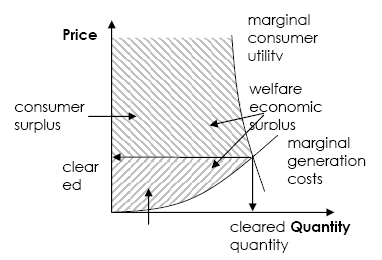
Figure 8: Assuming perfect competition, Power plants offer capacity according to their marginal generation costs. In the spot-market the market-price is equivalent to the marginal generation cost of the marginal power plant. The difference between the marginal utility of consumers and the marginal generation costs makes up the welfare-economic surplus of electricity generation.
Assuming perfect competition in the spot market, power plants offer capacity at their short run marginal costs (SRMC) according to economic theory. The SRMC corresponds to the cost of producing one extra unit of electricity at existing plants. The costs include fuel costs, variable operation and maintenance costs and any environmental costs that have been internalised in the market. Units with no or low fuel costs like wind, hydro power, nuclear and coal have relatively low SRMC, whereas gas or oil power plants have relatively high SRMC.
At times where electricity demand is relatively low (for example in summer time or at night) the market price will be fixed by units with low SRMC and vice versa in times with high demand. This fact is depicted in the graph below assuming no cost of CO2.
Figure 9: Supply and demand in the electricity spot-market
When CO2-costs are added gas and renewable energy power plants will become more competitive compared to coal power. Moreover, energy producers will get an incentive to run the power plants with high fuel efficiency, for example plants producing combined heat and power.
Adding CO2-costs may change the merit order of power plants as indicated in the figure below where coal moves up to become more expensive than gas power.
Figure 10: Including a CO2 price can change the merit order in the spot market
Based on the new merit order a new, higher price level is established. The relative cost increase of the various power plants depends on the fuel (emission factor), the fuel efficiency of the plant and the price of CO2. The increase in electricity prices is the extra cost of the marginal plant in each time segment. In time segments where renewable energy plants, nuclear or gas powered plants set the price there will be no or a quite low increase in the cost of power, whereas the increase may be quite significant in hours where coal or oil powered plants are marginal.
Figure 11: Supply and demand in the electricity spot-market, including CO2.
Table 7 shows how much the SRMC will increase for selected power plants, assuming a CO2 price of 20 euro/tonne.
| CO2 emission factor (tonne/TJ) | Electric efficiency, % | Emissions (kg/MWh) | Cost increase (€/MWh) | |
| Coal | 95 | 40 % | 855 | 17 |
| Gas CC | 57 | 50 % | 412 | 8 |
| Gas engine | 57 | 35 % | 589 | 12 |
| Oil | 78 | 35 % | 802 | 16 |
Table 7: The impact of CO2-quotas on the SRMC of selected fossil fuel technologies (condensing plants). Assumed CO2 quota price: 20 euro/tonne.
Experience from the Nordic market shows that the average emissions of the marginal power plant is approximately 700 g/kWh. This was for example reflected in the developments in electricity prices in connection with the release of 2005 verified emissions data in May 2006, when CO2-prices dropped from 30.6 Euro/tonne till 13.0 during one week (the CO2-price dropped because the actual level of the 2005 emissions were lower in aggregate than expected by many market observers). During the same week electricity prices declined by 12.7 euro/MWh, from 51.5 Euro/MWh to 38.8 Euro/MWh. Assuming that the change in the cost of allowances is the only reason for the decline in the electricity price (the interpretation by market analysts) this indicates that the emissions of the average marginal power plant is 720 g/kWh (12.7 euro/MWh / 17.6 euro/tonne = 0.72 tonne/MWh). Model analyses of the Nordic electricity system have shown a similar outcome (Elkraft System, 2003).
It is important to note that according to economic theory plant owners should add the cost of CO2 to their SRMC irregardless of the amount of quotas they have been allocated. The reason for this is that even if the plant has excess quotas, these quotas have a value determined by the market for quotas. If power is not produced and no CO2 emitted the quotas could otherwise be cashed for money (opportunity cost perspective). The degree to which the cost of quotas will be passed onto the SRMC could however be minimised if companies expect their future allocation of quotas to be impacted by their current level of production or emissions. This market failure, often referred to as “updating”, may appear, when allocation follows a sequential process, i.e. where allocation plans are decided for one commitment period at a time. Several studies have dealt with the issue of updating, see for example Neuhoff et al. (2006) for a comprehensive analysis.
In addition to stimulating changes on the production side, the demand will also be impacted by higher prices. An incentive is provided to reduce demand and invest in energy efficient end-use technologies leading eventually to reductions in CO2-emissions.
Increasing electricity prices will also add to the revenue of power producers. Assuming the marginal plant in the market emits 700 kg CO2/MWh as shown in the section above, the electricity price will increase by 14 euro/MWh on average. This almost covers the CO2-costs of a coal powered power plant (see Table 7). Allocation of free quotas to fossil fired plants based on their historic emissions or electricity generation can therefore be viewed as double-compensation.
In the spot market the EU ETS is an efficient tool to reduce CO2 emissions. Gas, nuclear and renewable energy power plants become more competitive compared to coal power, incentives are provided to run plants with high fuel efficiency and electricity prices increase – thereby stimulating energy efficiency/saving measures among consumers. Allocation to new fossil fuel plants will not have any direct impacts on the spot market. In the longer term allocation to new entrants may however change investments patterns (to be discussed below) and thereby the composition of power plants in the spot market.
4.2 Investments in power plants
Basic economic theory states that investments in the liberalised power market should take place when the (wholesale) price of power exceeds the long run marginal cost (LRMC) of producing power from a new power plant (IEA, 2003: 33). From an investor point of view many uncertainties are faced when considering investing in a new plant. How will fuel prices develop? Heat prices? CO2-prices (and other environmental costs)? And most importantly, how will the power price develop over time? Most power plants are capital intensive and have long technical life times (>15y) making them highly dependent on the future development in the market.
In the previous non-profit system the guaranteed market for power and the pre-paid power plants provided a very high degree of security for the economy of new plants. In the market based system the revenue in the spot market should be able to cover capital cost and other fixed cost of a new power plant. This is depicted in the figure below showing a fictive duration curve of the hourly electricity price.
In the hours where the electricity market price is higher than the plant’s SRMC a surplus revenue is generated to cover the fixed costs. When prices in the market are lower than the plant’s SRMC it is unprofitable for the generator to produce power. Figure 12 illustrates this principle on a price-duration curve - a method of illustration often used in the energy sector, where a value (e.g. price) which varies over time for some duration is represented by sorting in descending order, making it possible to identify e.g. profits as areas below the curve.

Figure 12: Duration curve of electricity prices. When the electricity market prices exceed the SRMC of the power plant revenue is generated to cover the plants capital costs and other fixed costs.
It can be assumed that the risk associated with investments in the liberalised will urge investors to require higher risk premiums than in the previous regime. This could for instance manifest it self in a demand for higher rates of return, when the feasibility of different investments are analysed – thus giving preference to technologies with low capital costs where fewer resources are risked.
A simple way to compare the relative attractiveness of different investment options in the electricity sector is to calculate their LRMC. The LRMC is the reduced average cost per unit of electricity produced taking into account all capital and operating costs.
Figure 13 compares the cost of five state-of-the art technologies in 2015: coal, gas, biomass, wind and nuclear[4]. All thermal technologies produce combined heat and power and the income from the heat sale has been deducted from the fuel costs indicated in the graphs (this explains the relative low fuel costs of for example the coal powered plant in the figure). Investment costs have been reduced over the economic life-time of the plants assuming a rate of return of 10 per cent (including investor risk premium).
The fuel prices for the figure below are based on the projections in the IEA World Energy Outlook 2006, assuming a crude oil price of 48 $/tonne in 2015 and coal prices at approximately the same level as today. The generation cost of the biomass plant is illustrated by using two sets of fuel prices, 2 euro per GJ and 4 euro per GJ respectively[5]. The first case illustrates a situation where the biomass is available as a residual product at a low cost subject to availability (e.g. residuals from a paper mill) and the second case a situation where the biomass is procured at world market prices.

Figure 13: Long Run Marginal Costs of new power plants
When the costs of CO2 is added to the LRMC (see Figure 14) it will become more attractive to invest in technologies with no or low CO2-emissions. Adding CO2 should also give incentives to invest in more efficient power plants, for example through the generation of combined heat and power. Investors in heat only plants should observe higher electricity prices and thus find greater incentive to combine the production of heat and power. Similarly it would become more attractive for owners of power plant to use the excess heat for district heating as well.

Figure 14: Long Run Marginal Costs of new power plants including the cost of CO2 (assuming a CO2 price of 20 euro/tonne.)
Allocation to new entrants under the EU ETS may however erode the incentives of the scheme. Figure 15 shows the LRMC of new power plants, when allocation to new fossil fired units is taken into consideration. In this case the allocation to new entrants is based on the German NAP. The dotted part of the bars indicate the cost of CO2 (assumed CO2 price: 20 euro/t). When allocation to new entrants is included the LRMC falls to the level of the red lines. It appears that when allocation to new entrants is included coal and gas fired power plants become significantly more attractive for investors. In the base case without allocation to new entrants gas and wind power are almost equally competitive. However, when including allocation to new entrants both gas and coal power plants become more attractive for investors than wind power.
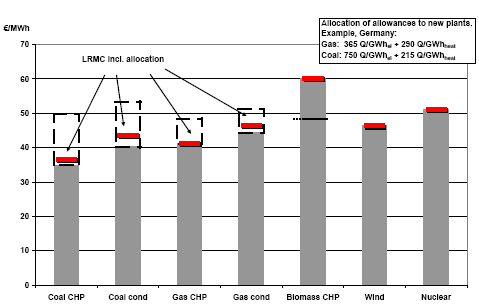
Figure 15: Long Run Marginal Costs of new power plants including the cost of CO2 (assuming a CO2 price of 20 euro/tonne.) and allocation to new entrants. Companies will receive their allocation annually. For the calculations in this figure, the value of future allowances has been reduced to net present value using a discount rate 10 % over time horizon of 10 years. Based on NAPs for 2005-7.
Figure 16 shows how great a share of total CO2-cost, which are covered by new entrant allocation for a new German power plant.
Allocation to new entrants will thereby lead to more investments in fossil fuel technologies and this way to increased CO2 emissions from the European energy sector. Alternatively, if the total cap remains unchanged, the increase in emissions will lead to higher carbon prices, which may stimulate more investments in low-carbon technologies, but also increase the purchases of credits from JI and CDM projects. Moreover, higher carbon prices will also increase the value of allocations to new entrants leading to self-perpetuating process. This issue will be dealt with in detail in section 5.7.1.
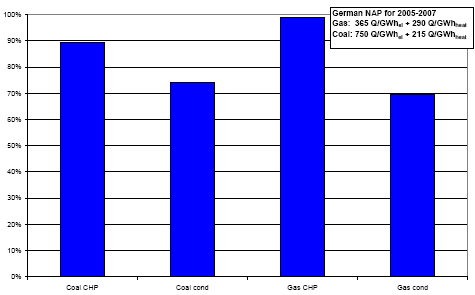
Figure 16: Share of CO2-costs covered by new entrant allocation. Companies will receive their allocation annually. For the calculations in this figure, the value of future allowances has been reduced to net present value using a discount rate 10 % over time horizon of 10 years. Based on the German NAPs for 2005-7.
Next to impacting the choice of technology, allocation to new entrants can also affect the geographical distribution of new investments. In Figure 17 the allocation to a new coal fired power plant is compared for five North European EU countries.
In Germany the allocation to new entrants is rather generous and the income from the sale of quotas is able to cover more than 60 per cent of total capital costs assuming a CO2-price of 20 euro/tonne. In Sweden the same figure is less than 20 per cent. A similar pattern is observed for gas power plants though the difference between countries is smaller (se Figure 18).
The large differences between countries can move investments from countries where they are most needed, from a market perspective or security of supply perspective, to countries with excess capacity where they are of less benefit.
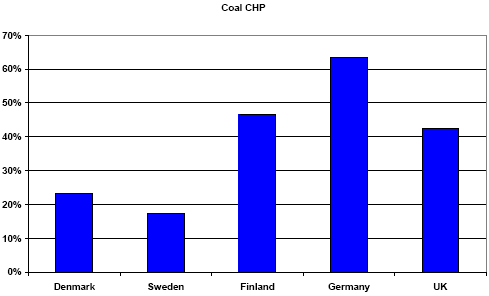
Figure 17: Allocation to new coal fired plants in selected EU countries. Measured as share of the plants total capital costs. CO2-price: 20 euro/tonne.
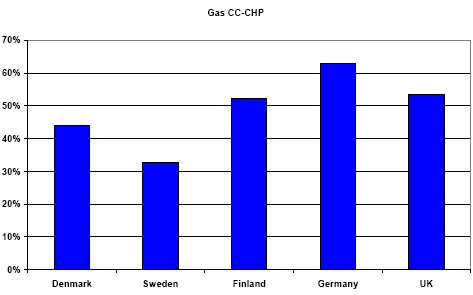
Figure 18: Allocation to new gas fired CHP-plants in selected EU countries. Measured as share of the plants total capital costs. CO2-price: 20 euro/tonne.
Allocation to new entrants may also affect the timing of new investments in the electricity market. As a rule of thumb, the electricity price in an underinvested market will increase until it reaches the LRMC of a new power plant. Since allocation to new entrants lowers the LRMC of the next power plant this is likely to move investments forward in time (see Figure 19). As a consequence more capacity may be deployed than what is economically efficient.
The support to new entrants can be compared to the fixed capacity payments, which are used in some countries – e.g. Spain, Argentina, Columbia and Chile – to ensure sufficient peak load capacity (Nordel, 2002). However, in the case of the EU ETS the support is only given to fossil fired plants.
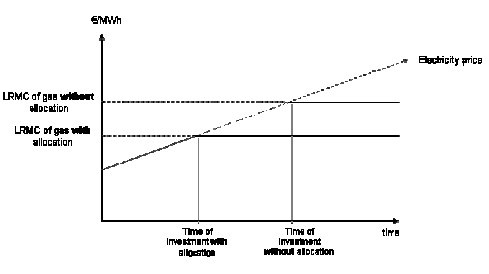
Figure 19: Timing of investments with- and without allocation to new entrants.
In summary, the EU ETS provides incentives to invest in technologies with low or no carbon emissions. Because of the allocation to new entrants these incentives are reduced in some countries eroding the incentives of the CO2-scheme.
Footnotes
[4] The new plants are assumed to be highly efficient: electrici efficiencies for coal condensing: 52.5 %, gas CC- condensing: 60 %, biomass CHP: 46.5 %.
[5] 4 €/GJ corresponds the international biomass price, which the Danish Energy Authority recommends for welfare-economic analyses in the energy sector (Danish Energy Authority 2005). 2 € reflects a case biomass is available as a residual product at a lower cost.
Version 1.0 June 2007, © Danish Environmental Protection Agency